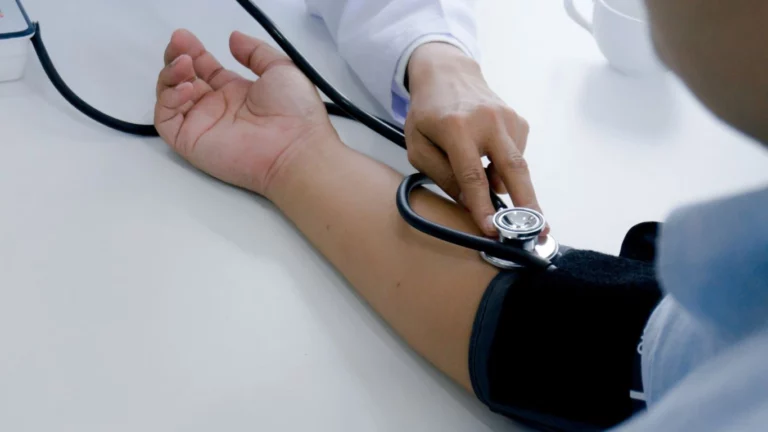Understanding Cholesterol and Blood Pressure: A Comprehensive Guide
Learn the complex relationship between high cholesterol & high blood pressure. Discover prevention strategies & medical interventions for optimal heart health.
Welcome to this comprehensive and in-depth article exploring the intricate relationship between high cholesterol and high blood pressure. These two conditions, when left unmanaged, can significantly increase the risk of cardiovascular diseases. Understanding the connection between high cholesterol and high blood pressure is crucial for adopting effective prevention and management strategies. In this article, we will delve deeper into the definitions, impact, and potential link between high cholesterol and high blood pressure. Additionally, we will explore various lifestyle factors, genetic considerations, and medical interventions to address these concerns proactively.
Introduction
Understanding High Cholesterol and High Blood Pressure
High cholesterol, or hypercholesterolemia, occurs when there are elevated levels of cholesterol in the blood. Cholesterol is a waxy, fat-like substance essential for various bodily functions, such as building cell membranes and producing hormones. However, excessive cholesterol can accumulate in the arteries, leading to the formation of plaque. Over time, this can narrow and harden the arteries, increasing the risk of cardiovascular problems, including heart attacks and strokes.
High blood pressure, or hypertension, refers to a condition characterized by increased force against the arterial walls as blood is pumped through the body. This extra strain on the heart and blood vessels can damage the arterial walls and, if left untreated, lead to heart disease, stroke, kidney damage, and other complications.
The Relationship Between Cholesterol and Blood Pressure
Research has consistently suggested a significant connection between high cholesterol and high blood pressure. Individuals with high cholesterol levels may have a higher likelihood of developing hypertension, and vice versa. While the exact cause-and-effect relationship is not fully understood, several factors contribute to the complex interplay between these conditions.
One possible link is endothelial dysfunction, a condition in which the endothelium (the inner lining of blood vessels) becomes damaged and unable to perform its normal functions. High cholesterol levels can lead to inflammation and oxidative stress, affecting the endothelial lining and causing impaired vasodilation (the widening of blood vessels) and increased vascular resistance. This contributes to higher blood pressure readings.
Moreover, atherosclerosis, the process of plaque buildup in the arteries due to high cholesterol, can also influence blood pressure. As plaque accumulates, the arteries become narrower, leading to increased resistance against blood flow and raising blood pressure levels.

High Cholesterol: Definition and Impact
Definition of High Cholesterol
High cholesterol is typically diagnosed when total cholesterol levels exceed 200 milligrams per deciliter (mg/dL). It is further divided into subcategories: low-density lipoprotein (LDL) cholesterol, often referred to as “bad cholesterol,” and high-density lipoprotein (HDL) cholesterol, known as “good cholesterol.” Elevated LDL cholesterol is associated with an increased risk of arterial plaque buildup, while higher levels of HDL cholesterol may offer some protection against cardiovascular diseases.
Risk Factors for High Cholesterol
Several factors can contribute to high cholesterol levels, including an unhealthy diet high in saturated and trans fats, lack of physical activity, obesity, smoking, and genetic predisposition. Additionally, certain medical conditions, such as diabetes and hypothyroidism, may also influence cholesterol levels. Research has shown that diets rich in fruits, vegetables, whole grains, and lean proteins, along with regular exercise, can help manage cholesterol levels effectively.
Health Implications of High Cholesterol
Unmanaged high cholesterol can lead to atherosclerosis, a condition in which plaque accumulates in the arteries, narrowing and hardening them. This restricts blood flow and may eventually lead to heart attacks or strokes. However, not all cholesterol is harmful; HDL cholesterol plays a protective role by helping to transport excess cholesterol from the blood vessels to the liver for removal from the body. Therefore, maintaining a healthy balance between LDL and HDL cholesterol is essential for overall cardiovascular health.

High Blood Pressure: Overview and Causes
Definition of High Blood Pressure
High blood pressure is diagnosed when blood pressure readings consistently exceed 130/80 mmHg. The first number represents systolic pressure (pressure during heartbeats), and the second number represents diastolic pressure (pressure between heartbeats). High blood pressure forces the heart to work harder, putting strain on the cardiovascular system.
Factors Contributing to High Blood Pressure
Various factors can contribute to the development of high blood pressure, including a sedentary lifestyle, unhealthy dietary habits, excessive salt intake, alcohol consumption, stress, and family history. Age, race, and certain underlying medical conditions can also increase the risk of hypertension.
Research indicates that sodium intake plays a significant role in blood pressure regulation. Excessive sodium consumption can cause the body to retain more water, leading to increased blood volume and elevated blood pressure. Reducing sodium intake, along with adopting a diet rich in potassium (found in fruits and vegetables), has been shown to help manage blood pressure levels effectively.
Effects of High Blood Pressure on Health
Uncontrolled high blood pressure can damage the blood vessels, heart, and other organs. It may lead to serious complications such as heart attacks, strokes, heart failure, kidney damage, and vision problems. Regular blood pressure monitoring and appropriate lifestyle changes can help manage this condition effectively.

The Link between High Cholesterol and High Blood Pressure
Reviewing Scientific Studies and Research
A multitude of scientific studies have investigated the potential link between high cholesterol and high blood pressure. A review of the existing research provides valuable insights into the mechanisms underlying their association.
One study published in the journal Hypertension examined the impact of cholesterol levels on blood pressure in a group of middle-aged adults. The results indicated that higher LDL cholesterol levels were associated with an increased risk of hypertension, independent of other risk factors. This suggests that cholesterol levels may directly influence blood pressure regulation.
Another study published in the American Journal of Hypertension explored the relationship between arterial stiffness, cholesterol levels, and blood pressure. The researchers found that individuals with elevated cholesterol levels exhibited increased arterial stiffness, which contributed to higher blood pressure readings. This indicates that cholesterol-induced arterial changes may play a role in hypertension development.
These studies and many others support the notion that high cholesterol can impact blood pressure through various physiological pathways. However, further research is needed to fully elucidate the complex relationship between these two conditions.
Mechanisms Explaining the Connection
The connection between high cholesterol and high blood pressure lies in several underlying mechanisms that influence cardiovascular health. Some of the key mechanisms include:
- Endothelial Dysfunction: As mentioned earlier, endothelial dysfunction can occur when the endothelium lining the blood vessels becomes damaged. High cholesterol levels contribute to oxidative stress and inflammation, leading to impaired endothelial function. This dysfunction can disrupt the normal dilation and constriction of blood vessels, impacting blood pressure regulation.
- Renin-Angiotensin System (RAS) Activation: The RAS is a hormone system that plays a vital role in regulating blood pressure. Elevated cholesterol levels may activate the RAS, leading to increased vasoconstriction (narrowing of blood vessels) and salt and water retention, which can raise blood pressure.
- Inflammation and Immune Response: High cholesterol levels can trigger an inflammatory response within the blood vessels. Chronic inflammation can damage the vessel walls and impair their ability to relax and contract, affecting blood pressure regulation.
- Insulin Resistance: Research suggests that insulin resistance, often associated with high cholesterol and obesity, may contribute to hypertension. Insulin resistance affects blood vessel function and can lead to increased blood pressure.
Understanding the Role of Blood Vessels
Cholesterol deposits can accumulate in the walls of blood vessels, leading to atherosclerosis. This narrowing of blood vessels can increase resistance to blood flow, causing blood pressure to rise. Additionally, atherosclerotic plaques are prone to rupture, potentially triggering blood clot formation and further complicating blood pressure regulation.
The intricate relationship between cholesterol and blood pressure underscores the importance of a comprehensive approach to cardiovascular health. Addressing both conditions through lifestyle modifications and appropriate medical interventions can significantly reduce the risk of cardiovascular diseases.

Lifestyle and Diet Factors
Impact of Diet on Cholesterol and Blood Pressure
Diet plays a crucial role in managing both cholesterol and blood pressure levels. Adopting a heart-healthy diet can positively influence lipid profiles and blood pressure readings. Key dietary recommendations for improving cholesterol and blood pressure include:
- Limiting Saturated and Trans Fats: Foods high in saturated and trans fats, such as red meat, full-fat dairy products, and processed snacks, can raise LDL cholesterol levels. Replacing these fats with healthier options like unsaturated fats found in olive oil, avocados, and nuts can help improve lipid profiles.
- Incorporating Fruits and Vegetables: Fruits and vegetables are rich in fiber, antioxidants, and other heart-healthy nutrients. They can help lower LDL cholesterol levels and reduce blood pressure. Aim to fill half your plate with colorful fruits and vegetables at every meal.
- Choosing Whole Grains: Whole grains like oats, brown rice, and quinoa are high in fiber, which can help lower cholesterol levels and promote heart health. Choose whole-grain options over refined grains whenever possible.
- Limiting Sodium Intake: High sodium intake is associated with elevated blood pressure. Minimize the use of salt during cooking and at the table, and be mindful of hidden sources of sodium in processed and packaged foods.
- Including Lean Proteins: Opt for lean protein sources such as poultry, fish, legumes, and tofu. These proteins are lower in saturated fat and can contribute to overall heart health.
- Moderating Alcohol Consumption: While moderate alcohol consumption may have some cardiovascular benefits, excessive alcohol intake can raise blood pressure. Limit alcohol consumption to moderate levels, which means up to one drink per day for women and up to two drinks per day for men.
Research has shown that adherence to a dietary approach known as the Dietary Approaches to Stop Hypertension (DASH) diet can have a significant impact on both cholesterol and blood pressure levels. The DASH diet emphasizes fruits, vegetables, whole grains, lean proteins, and low-fat dairy while reducing sodium intake. Studies have demonstrated that individuals following the DASH diet experience improvements in both lipid profiles and blood pressure readings.

Importance of Physical Activity
Physical activity plays a vital role in managing cholesterol and blood pressure levels. Regular exercise can have positive effects on both lipid profiles and blood pressure readings. Key benefits of physical activity for cardiovascular health include:
- Improving Cholesterol Levels: Engaging in regular aerobic exercise can raise HDL cholesterol levels, which can help transport excess cholesterol away from the blood vessels to the liver for elimination.
- Enhancing Blood Vessel Function: Exercise promotes better blood vessel function, reducing the risk of endothelial dysfunction and contributing to healthy blood pressure regulation.
- Managing Weight: Regular physical activity helps with weight management, which is crucial for overall cardiovascular health. Losing excess weight can lead to improvements in both cholesterol and blood pressure levels.
- Reducing Stress: Exercise can help reduce stress levels, which, in turn, can have a positive impact on blood pressure.
The American Heart Association recommends at least 150 minutes of moderate-intensity aerobic activity or 75 minutes of vigorous-intensity aerobic activity per week, along with muscle-strengthening activities at least two days a week. Examples of aerobic exercises include brisk walking, jogging, swimming, cycling, and dancing. Strength training exercises can include weightlifting, resistance band workouts, and bodyweight exercises like push-ups and squats.
Managing Weight for Cardiovascular Health
Being overweight or obese is a significant risk factor for both high cholesterol and high blood pressure. Excess body weight can lead to metabolic changes that influence lipid profiles and blood pressure regulation. Additionally, obesity is associated with insulin resistance, which can further impact cardiovascular health.
Weight management is an essential aspect of preventing and managing high cholesterol and high blood pressure. Losing as little as 5 to 10 percent of body weight can lead to significant improvements in lipid profiles and blood pressure readings.
Individuals can achieve weight loss through a combination of dietary changes and increased physical activity. The goal should be to create a calorie deficit by consuming fewer calories than the body expends. This can be achieved by following a balanced diet and increasing daily physical activity levels.
Working with healthcare professionals, such as registered dietitians or exercise specialists, can provide personalized guidance and support in developing a sustainable weight management plan.

Other Contributing Factors
Genetics and Family History
Genetics and family history play a significant role in determining an individual’s susceptibility to high cholesterol and high blood pressure. Some individuals may have a genetic predisposition to high cholesterol levels, while others may have a family history of hypertension.
If you have a family history of either condition, it is essential to be proactive about monitoring your cholesterol and blood pressure levels regularly. Understanding your genetic risk can motivate you to make positive lifestyle changes to mitigate potential health risks.
In some cases, genetic testing may be recommended to identify specific genetic markers associated with high cholesterol or hypertension. This information can guide healthcare providers in developing personalized prevention and management strategies.
Age and Gender Considerations
Age is a significant risk factor for both high cholesterol and high blood pressure. As people age, their cholesterol levels tend to rise, and the risk of hypertension increases. Additionally, age-related changes in blood vessels can impact blood pressure regulation.
In terms of gender, men are more likely to develop high blood pressure before the age of 45, while women may have a higher risk of hypertension after menopause. Hormonal changes during menopause can influence blood pressure levels, highlighting the importance of regular health check-ups for women during this life stage.
Co-existing Medical Conditions
Certain medical conditions can influence cholesterol and blood pressure levels. Diabetes, for example, is associated with an increased risk of high cholesterol and hypertension. Uncontrolled diabetes can contribute to endothelial dysfunction and arterial stiffness, affecting blood pressure regulation.
Other medical conditions, such as kidney disease, thyroid disorders, and chronic kidney disease, can also impact cholesterol and blood pressure levels. Managing these underlying conditions effectively is essential for overall cardiovascular health.
Individuals with co-existing medical conditions should work closely with their healthcare providers to develop a comprehensive treatment plan that addresses all aspects of their health.

Prevention and Management
Adopting a Heart-Healthy Diet
Adopting a heart-healthy diet is one of the most effective ways to prevent and manage high cholesterol and high blood pressure. The following strategies can help individuals make healthier food choices:
- Reduce Intake of Saturated and Trans Fats: Saturated and trans fats raise LDL cholesterol levels and should be limited. Instead, opt for healthier fats like monounsaturated and polyunsaturated fats found in olive oil, avocados, nuts, and seeds.
- Increase Consumption of Omega-3 Fatty Acids: Omega-3 fatty acids, found in fatty fish like salmon, mackerel, and trout, have been shown to have heart-protective benefits. Aim to include fish in your diet at least twice a week.
- Choose Lean Protein Sources: Replace red meat with lean protein sources like poultry, fish, legumes, and tofu. These options are lower in saturated fat and cholesterol.
- Incorporate Fiber-Rich Foods: High-fiber foods like whole grains, fruits, vegetables, and legumes can help lower LDL cholesterol levels and improve heart health.
- Reduce Sodium Intake: Excess sodium can contribute to high blood pressure. Limit the use of salt in cooking and at the table, and choose low-sodium alternatives for processed foods.
- Limit Added Sugars: High sugar intake can lead to weight gain and contribute to metabolic changes. Reduce the consumption of sugary beverages, desserts, and processed snacks.
- Stay Hydrated: Drinking plenty of water is essential for overall health and may also help with weight management.
Remember that a heart-healthy diet should be sustainable and enjoyable. Finding balance and incorporating a variety of nutrient-dense foods into your meals can contribute to long-term success in managing cholesterol and blood pressure levels.

Regular Exercise and Fitness
Physical activity is a cornerstone of cardiovascular health. Regular exercise can provide a wide range of benefits, including:
- Improving Cardiovascular Endurance: Engaging in aerobic exercise can enhance cardiovascular endurance, making the heart more efficient at pumping blood and reducing the workload on the heart.
- Strengthening Muscles: Strength training exercises can improve muscle tone and increase metabolism, contributing to weight management.
- Enhancing Blood Flow: Physical activity helps improve blood flow throughout the body, promoting better oxygen and nutrient delivery to tissues and organs.
- Reducing Stress: Exercise can help reduce stress levels, which can positively impact blood pressure.
It is essential to choose activities that you enjoy and can incorporate into your daily routine. Aim for a combination of aerobic exercises (such as walking, jogging, cycling, or swimming) and strength training exercises (using weights, resistance bands, or bodyweight exercises) to experience a comprehensive range of health benefits.
While regular physical activity is beneficial, it is crucial to start at a comfortable level and gradually increase the intensity and duration of your workouts. Consult with a healthcare professional before starting a new exercise program, especially if you have any underlying health concerns.
Lifestyle Changes for Optimal Cholesterol and Blood Pressure
In addition to diet and exercise, other lifestyle factors can influence cholesterol and blood pressure levels:
- Quit Smoking: Smoking damages the blood vessels and contributes to atherosclerosis. Quitting smoking is one of the most significant steps you can take to improve cardiovascular health.
- Manage Stress: Chronic stress can raise blood pressure and negatively impact overall health. Incorporate stress-reduction techniques into your daily routine, such as meditation, yoga, deep breathing exercises, or spending time in nature.
- Get Adequate Sleep: Poor sleep quality or inadequate sleep can affect hormone levels and increase the risk of high blood pressure. Aim for 7 to 9 hours of quality sleep each night.
- Avoid Excessive Alcohol Consumption: While moderate alcohol intake may have some heart benefits, excessive alcohol consumption can raise blood pressure. Limit alcohol intake to moderate levels, as recommended by healthcare professionals.
Adopting a holistic approach to lifestyle management can significantly impact cholesterol and blood pressure levels. These positive changes not only benefit cardiovascular health but also contribute to overall well-being and longevity.

Medical Interventions
Medications for High Cholesterol and High Blood Pressure
In some cases, lifestyle changes may not be sufficient to control cholesterol and blood pressure levels. In such situations, healthcare providers may prescribe medications to help manage these conditions effectively.
For High Cholesterol
Statins are a class of medications commonly used to lower LDL cholesterol levels. They work by inhibiting an enzyme involved in cholesterol production, thus reducing the amount of LDL cholesterol in the blood. Statins have been shown to be effective in reducing the risk of cardiovascular events, such as heart attacks and strokes, in individuals with high cholesterol levels.
In addition to statins, other medications, such as bile acid sequestrants, niacin, and cholesterol absorption inhibitors, may be prescribed to address specific cholesterol concerns.
For High Blood Pressure:
Antihypertensive medications are used to treat high blood pressure and can help reduce the strain on the heart and blood vessels. These medications work by various mechanisms, including relaxing blood vessels, reducing fluid volume, and inhibiting certain hormones that affect blood pressure.
There are several classes of antihypertensive medications, and healthcare providers will choose the most appropriate option based on an individual’s specific health needs and response to treatment. Some common classes of antihypertensive medications include angiotensin-converting enzyme (ACE) inhibitors, angiotensin receptor blockers (ARBs), beta-blockers, calcium channel blockers, and diuretics.
It is essential to follow medication guidelines and attend regular check-ups to monitor progress and address any concerns. Additionally, healthcare providers may adjust medication dosages or change medications if necessary to achieve optimal blood pressure and cholesterol levels.

Consultation with Healthcare Professionals
If you have concerns about your cholesterol or blood pressure levels, seeking advice from healthcare professionals is crucial. They can assess your individual risk factors, provide personalized recommendations, and monitor your progress over time. Regular health screenings are essential for early detection and prevention.
Your healthcare provider may conduct blood tests to measure cholesterol levels and blood pressure readings. Based on these results and other health information, they can create a comprehensive plan to address any concerns and manage your cardiovascular health effectively.
Monitoring and Managing Cholesterol and Blood Pressure Levels
Consistent monitoring of cholesterol and blood pressure levels is essential for effective management. Keeping track of your readings allows you and your healthcare provider to assess your progress and make necessary adjustments to your treatment plan.
For individuals with high cholesterol, regular lipid panels are necessary to monitor LDL cholesterol levels. For those with hypertension, blood pressure measurements are routinely taken to evaluate the effectiveness of lifestyle modifications and medications.
Additionally, lifestyle changes and medication adjustments may be needed over time. It is essential to maintain open communication with your healthcare provider, report any changes in your health, and follow their recommendations for ongoing care.

Conclusion
Recapitulation of Findings
In conclusion, the relationship between high cholesterol and high blood pressure is a complex interplay with multiple contributing factors. Elevated cholesterol levels can potentially impact blood vessel function, leading to hypertension. Conversely, uncontrolled high blood pressure can also affect cholesterol metabolism. Both conditions share similar risk factors and warrant proactive management to reduce the risk of cardiovascular diseases.
Final Thoughts on the Cholesterol-Blood Pressure Relationship
Addressing high cholesterol and high blood pressure requires a multifaceted approach that includes lifestyle modifications, medical interventions, and ongoing monitoring. By making positive changes to diet, exercise habits, and overall lifestyle, individuals can work towards maintaining healthy cholesterol and blood pressure levels and promoting long-term cardiovascular health.
Remember, it is essential to consult with healthcare professionals to assess your specific health needs and develop a personalized plan for managing cholesterol and blood pressure effectively. Taking proactive steps to address these conditions can have a significant impact on your overall well-being and quality of life.
References
- Benjamin EJ, Blaha MJ, Chiuve SE, Cushman M, Das SR, et al. Heart disease and stroke statistics-2017 update: a report from the American Heart Association. Circulation. 2017;135(10):e146–e603. doi: 10.1161/CIR.0000000000000485. [PMC free article] [PubMed] [CrossRef] [Google Scholar]
- Wong ND, Lopez V, Tang S, Williams GR. Prevalence, treatment, and control of combined hypertension and hypercholesterolemia in the United States. Am. J. Cardiol. 2006;98(2):204–208. doi: 10.1016/j.amjcard.2006.01.079. [PubMed] [CrossRef] [Google Scholar]
- Laurenzi M, Mancini M, Menotti A, Stamler J, Stamler R, et al. A multiple risk factors in hypertension: results from the Gubbio study. J. Hypertens. 1990;8(Suppl.):S7–S12. doi: 10.1097/00004872-199003001-00003. [PubMed] [CrossRef] [Google Scholar]
Disclaimer: The information provided in this article is for educational purposes only and should not be considered medical advice. Always consult with a healthcare professional for personalized guidance on managing cholesterol and blood pressure.

Camellia Wulansari is a dedicated Medical Assistant at a local clinic and a passionate health writer at Healthusias.com. With years of hands-on experience in patient care and a deep interest in preventive medicine, she bridges the gap between clinical knowledge and accessible health information. Camellia specializes in writing about digestive health, chronic conditions like GERD and hypertension, respiratory issues, and autoimmune diseases, aiming to empower readers with practical, easy-to-understand insights. When she’s not assisting patients or writing, you’ll find her enjoying quiet mornings with coffee and a medical journal in hand—or jamming to her favorite metal band, Lamb of God.






